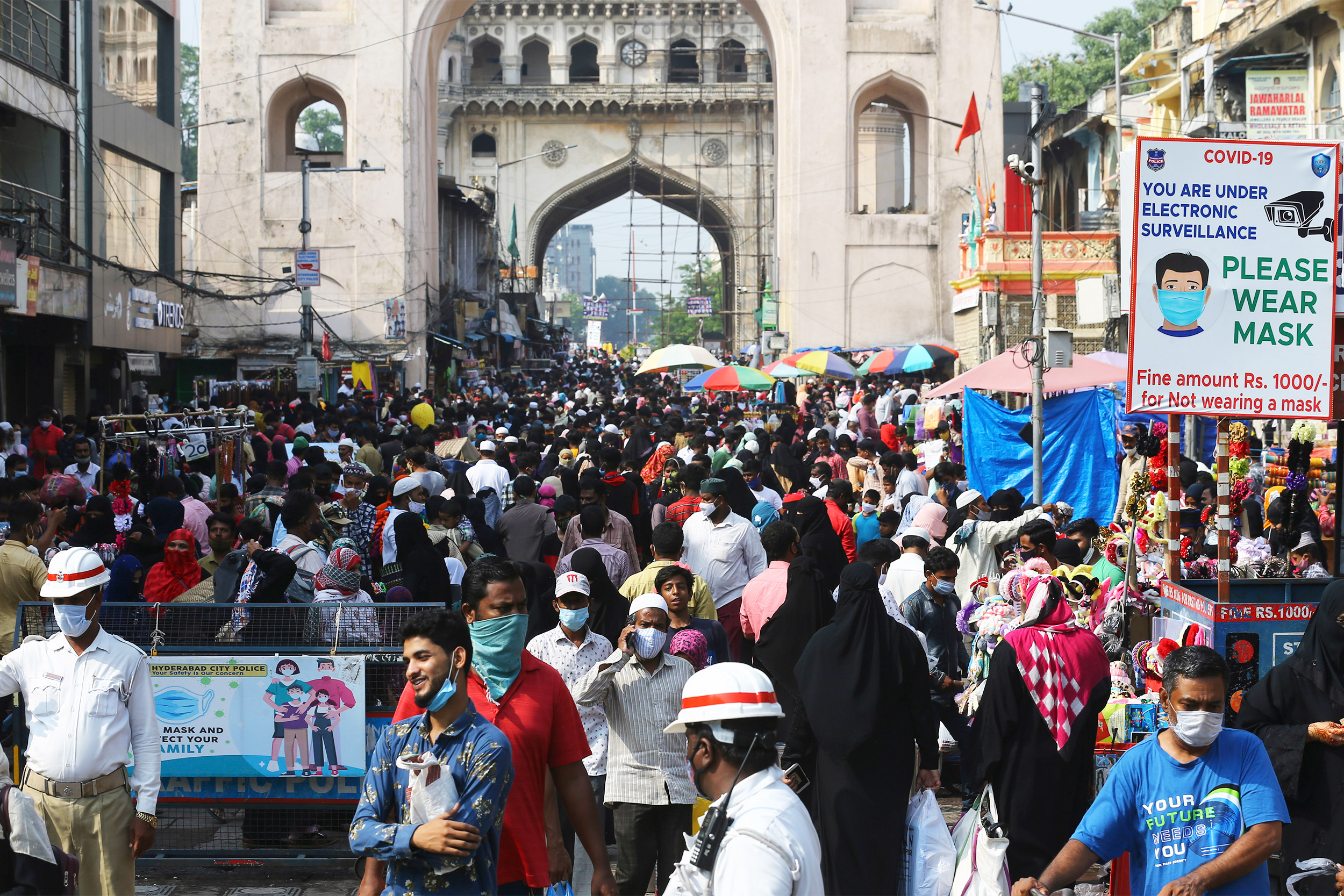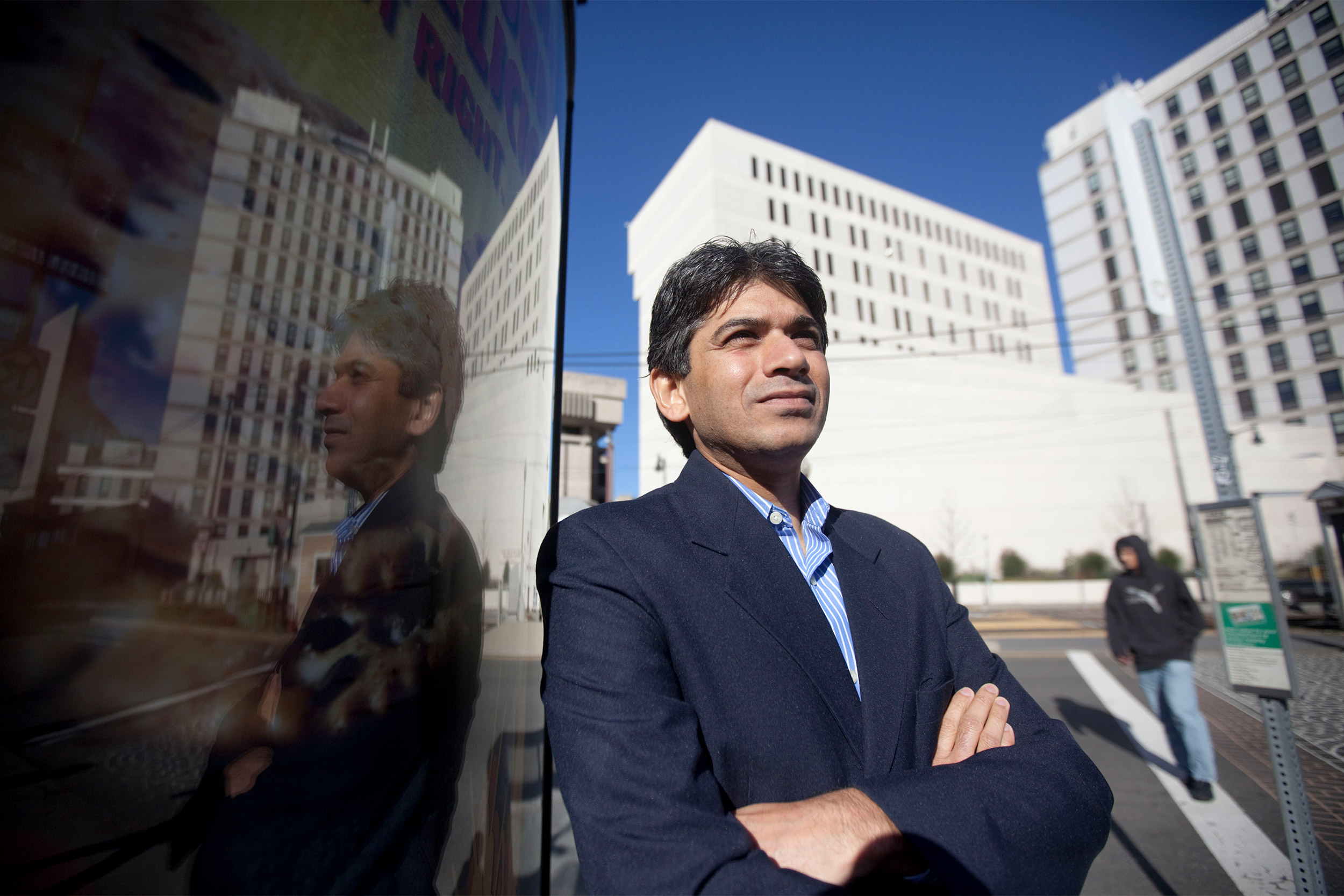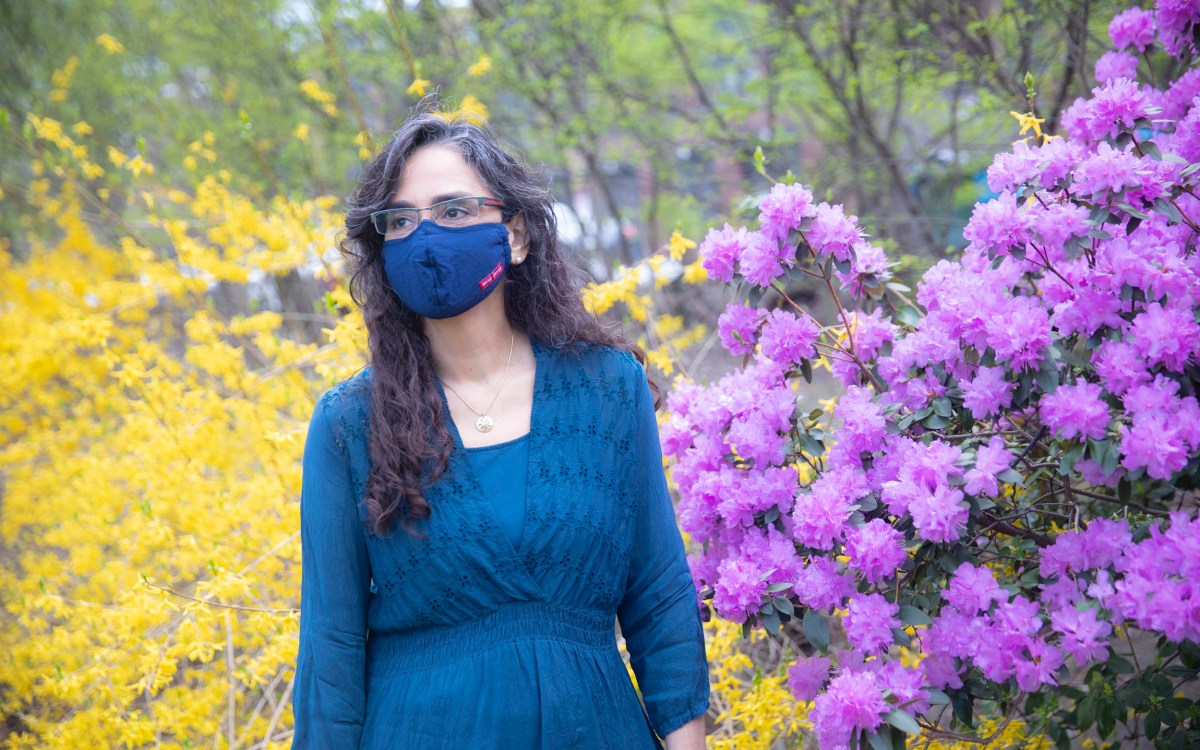
In Hyderabad, India, a few hours reprieve from a lockdown on Thursday brought people together in a marketplace. A sign mandated masks and warned people they were being watched and a fine would be imposed if they were without.
AP Photo/Mahesh Kumar A.
‘In India, anything and everything is a super-spreader event’
Chan’s Subramanian offers on-the-ground perspective as COVID-19 surges
In recent weeks, India has become a major COVID-19 hotspot, with millions of new cases a month even as vaccination efforts have been ramping up. S.V. Subramanian, professor of population health and geography at the Harvard T.H. Chan School of Public Health, arrived there to further his collaboration with India government officials just before the most recent surge became apparent, but instead he has been isolating as best he can at an academy for civil servants north of Delhi, in Mussoorie in the Himalayas. The Gazette spoke with Subramanian about the situation there.
Q&A
S.V. Subramanian
GAZETTE: Tell me why you’re in India, and how long you have been there?
SUBRAMANIAN: I came here about a month and a half ago. I have this important policy research project wherein we are producing value-added data indicators of child health at four geographic scales: villages, more than half a million; parliamentary constituencies, 543; assembly constituencies, 4,000 of them because health and education issues are more a state-level issue in India rather than a national issue; and then districts, more than 700. We just had our paper in PNAS published on coming up with village-level estimates for half a million villagers for the first time.
Since March 2020, when the world was grounded, we have been mostly focused on the science behind producing those value-added data. The second part of the project is disseminating that through an online public platform, a geospatial platform where one can visualize crucial policy indicators at multiple geographic scales. Visualizing such indicators is not new for the districts, but we are the first to have the content and methods to visualize at the parliamentary constituency, assembly constituency, and village level. And in that part of the project, my two core partners are a leading policy think tank for the government of India, which is called NITI Aayog, the National Institution for Transforming India, based in New Delhi. The other one runs the campus where I am, which is the Lal Bahadur Shastri National Academy of Administration, which trains the civil servants in India, who are in turn responsible for carrying out development programs in India at all levels.
GAZETTE: I know the civil service is very important in India.
SUBRAMANIAN: They are very privileged in the sense that they have tenure, and they get trained here, from entry up to higher levels. I wanted to talk to the people who would be using my platform. A district has on average 1,000 villages, and let’s say they don’t know which villages they should focus on for supplementing with iron or folic acid tablets for anemia control or prevention. We are producing those kinds of data where they can visualize villages. My aspiration would be for every district headquarters to have live monitoring where one can see exactly which villages need attention and “that’s the village I want to put my money in,” and have that kind of precision targeting to policy implementation.
The government of India, which is open and running, invited me to come as a guest of theirs, both in Delhi and here, though I’ve not been able to go to Delhi. The invitation was so I can talk to policymakers, meet some politicians, and learn what might be most helpful for them and their offices and design our platform accordingly. At that time everything was open in India. I also knew Harvard was not going to open until fall, and it was clear that my teaching was not going to be in the classroom.

“It’s been almost a perfect storm for India,” said S.V. Subramanian, professor of population health and geography at the Harvard T.H. Chan School of Public Health.
Kris Snibbe/Harvard file photo
GAZETTE: So the surge hadn’t happened yet?
SUBRAMANIAN: It started like two weeks after I arrived, in April.
GAZETTE: Is it just you there or are there other Harvard folks who you work with as well?
SUBRAMANIAN: It’s just me. I am the [primary investigator] of the grant. At Harvard, the only other collaborator is the CGA [Center for Geographic Analysis] because it involves a lot of geographic solutions.
GAZETTE: No fellows or graduate students or anything like that?
SUBRAMANIAN: No. I thought I’d have couple of postdocs come while I’m here, but all that kind of went away after the first three weeks. And I am not hopeful that would be possible in the near future.
GAZETTE: What’s your living situation? Do you have an apartment in the city and commute to the university campus?
SUBRAMANIAN: I’m on campus in a place called Mussoorie, which is where the training academy is. It’s in the lower Himalayas, up to about 3,000 meters in a new state called Uttarakhand. It’s a beautiful campus and very safe. I’m quite privileged to be here. My office is in the next building, but there’s nobody else in my building right now. There are offices below and there’s a mess [cafeteria] here. In Delhi the academy has a guest house, which I was planning to use during my short-term visits to NITI. The plan was that I would come straight here and make this my base, because this place is a bit more academic, and Delhi is like five hours away by car. I was thinking I would go to Delhi every two weeks for four or five days — my mom’s there as well — but I have not been to Delhi since I came here. I have been strongly discouraged by my hosts, who have taken it upon themselves to ensure my safety, which is extremely kind of them and I am most grateful and fortunate for that.
GAZETTE: Is the campus open? Are there students there or is India as shut down as things have been here?
SUBRAMANIAN: This is the first week where the mess is closed. The group of trainees that was here when I arrived were supposed to be here for six weeks, but starting in week three they switched to online, and they were all confined to their rooms. They were doing their training online, and food was being delivered to them in their respective rooms. This week they shut down everything. The kitchen closed, and next week the batch of officer trainees who started a couple of years back were supposed to return after their first stint in their districts. However they will also not be coming here in person. They’re saying that this is only until Friday, but I seriously doubt it. They have multiple campuses, and there is another campus just about a half a kilometer away that they turned into a COVID care center. That facility — about a 45-bed facility — is completely full.
“In hindsight, I do not think it was prudent to put all of our apples in the vaccine basket and ignore treatment”
S.V. Subramanian
GAZETTE: Are you seeing evidence of the COVID spike in your day-to-day life beyond these shutdowns?
SUBRAMANIAN: Certainly, the surge is real here. Mussoorie has one civil hospital, but it’s pretty basic, the closest big hospital would be in Dehradun, which is about 20 kilometers away, all downhill. Of course, this is a very privileged place, so they have three ambulances, and when someone’s illness is beyond the COVID care center’s ability to handle — you need a ventilator, for example — they push you to Dehradun or they helicopter you to Delhi. A couple of people have gone there. So, there has been a surge, but the deadliness, I have not seen here. I have not witnessed live any images of the sort the media is reporting from Delhi or other metro centers.
GAZETTE: How worried are the people you’re dealing with?
SUBRAMANIAN: People are worried. The campus is shut; academy officers are not coming in. I have the entire campus to myself; I can roam around anywhere. This place is constantly being cleaned, though. The only other people are here sweeping because there are monkeys, and the leaves are falling — it is a beautifully kept place. I often go on walks to uncrowded areas, and I encounter residents who are daily-wage folks, many working in the academy. When I talked to the people in the cafeteria, before it closed, many of them are contractual and on daily wage, very few are permanent. They’re all worried, saying, “I don’t know what we’re going to do because we’re not going to have income,” and at the same time, the officer class are all in their homes. It’s the reality of the situation in places like India, or even in the United States.
One cleaning woman I saw, she was really sick, and she said, “Oh, I took the vaccine yesterday and have not been feeling well at all.” I said, “Why don’t you take the day off?” and her response was, “I can’t afford to.” That really kind of struck me; it must be for $4 or less per day. My mom had also taken the vaccine and had a bad reaction. I’m seeing a lot of reinfection post-vaccine here — which is the AstraZeneca one.
My mother got the vaccine, and the next day she was fine. The third day, she felt sick. She was sick for 2½ weeks; I almost feel that she got infected, and now she’s become very weak.
GAZETTE: Did she get tested after the vaccine? That illness sounds unusual.
SUBRAMANIAN: No. Plus, testing capacity is very low, and infection rates are a function of testing. So, if the numbers are 6 million cases in April, multiply that by three or four times to get people who were probably positive for the month of April in India. Even the IHME [Institute for Health Metrics and Evaluation] estimate is 13 million.
GAZETTE: So you think it’s 18 million to 24 million?
SUBRAMANIAN: Easily, because we know how quickly this spreads. Now, that same logic should apply to reinfection, because the rate is a function of who will go and get tested and, after getting a vaccine, they will shrug it off if it is not fatal. I was talking to a colleague at Delhi’s second-largest hospital, and it seems very common that health care workers are getting reinfected — in her department of 20 people, at least a quarter of them. The government of India put reinfection rates at 0.04 percent, and even with that, which is a dramatic underestimate, 0.04 percent in India is still a big number.
It’s been almost a perfect storm for India, a combination of things like that super-spreader event of the Kumbh Mela [mass religious festival on the banks of the Ganges River] or the election rallies. But January had the farmers’ protest, and nothing happened. Tens of thousands descended into Delhi, and nothing happened. But in India, anything and everything is a super-spreader event. You go to work in Bombay: That’s a super-spreader event on a train. Everything in India is a super-spreader event for the vast majority of people. It is an inconvenience for me to sit inside my room, but for others this is simply not feasible.
GAZETTE: Is that because so many people are trying to live their lives, taking trains to work?
SUBRAMANIAN: Yes. They opened up the trains, so people will travel. Some people had to do their jobs. By the definition of Massachusetts overcrowding, the entire Indian housing situation would be illegal, every single home. So, we can put the surge on the Kumbh Mela, but that’s just part of the perfect storm. And India doesn’t have the deep pockets that the U.S. has. India already is stretched. They can’t do a lockdown like they did last time. Another issue is this whole variant story.
I have seen everywhere, in media reports, that India’s vaccination rollout has been terrible, but what’s the metric they are using? India has 157 million vaccine shots in the arms, third, when it comes to actual shot in the arms. Who’s number one? China. Second is the U.S. Compare the public health infrastructure of those three countries, and India probably stands nowhere close to the U.S. China’s numbers are not easily verifiable, but the U.S. we know. So India, with its pathetic infrastructure, has administered about a million a day and have administered over 3 million on a few days.
GAZETTE: I was looking at your vaccine tracker, and it says doses administered today, about 1.8 million.
More like this
SUBRAMANIAN: Some days it has exceeded 2 million, 1 million was the lowest. I think you can’t blame the country because they have a billion-plus people. India has vaccinated half of the U.S. population — 157 million with first dose. But it’s exactly during this time when the surge ramped up, and The Wall Street Journal carried a picture two, three days ago, “In Mumbai, people are waiting for vaccine.” All of them are gray-haired, kind of middle class, in a vaccination center. And that looked like a super-spreader event to me. Everybody is sitting next to each other waiting for a vaccine, literally close to each other.
GAZETTE: So not distancing or wearing masks?
SUBRAMANIAN: Definitely not distancing. Masks, yes, but not perhaps the one needed at that close proximity, such as triple-layered or N-95. You know, India has been carpet bombing with the vaccine, distributing it across the country — more than 600 districts have been covered with some doses. There is variability between places and districts — as we show with the vaccine tracker — but not the kind of variability that we might see for some other data. The difference between Kerala and Bihar, they would be on two different planets, but not for the vaccine. Was that a good strategy? I don’t know.
GAZETTE: Do you think that if they had taken precautions at the vaccine centers, would that change your opinion?
SUBRAMANIAN: That would certainly help, but can that be realistically implemented? I truly wonder if we should have targeted all 700 districts or whether we should have focused on fewer places such as Mumbai, Delhi, where there is high population density and it’s likely to spread, rather than everywhere. Hindsight is perfect vision, and if India had done that, the editorials and media would have slammed India for being inequitable.
GAZETTE: India has the manufacturing capacity to produce a lot of vaccine, right?
SUBRAMANIAN: Yes, it has the world’s largest vaccine producer, the Serum Institute. They can produce close to like 70 million, 100 million [doses a month], but the raw material has to be imported, and the global supply chain was constrained because of the embargos different countries had on raw materials. The U.S. had an embargo, which I believe Biden removed. In July, I read, they plan to ramp up to 100 million a month.
GAZETTE: How do you see this ending? Can India vaccinate its way out of this? Or, if they’re not taking appropriate precautions at the vaccine centers, is that potentially counterproductive? Do they have another lockdown or does it just run?
SUBRAMANIAN: Now we are in mitigation mode, and I feel that there will be a ramp up of antivirals and treatment options. I’m not talking about the surge, the need for oxygen, and all that. But I’m saying that the way it will end in India is that treatment may need to be ramped up. I don’t think India — or any country — can vaccinate its way out of it. The Seychelles story (with a surge of cases despite one of the world’s highest rates of vaccination, with the AstraZeneca and Chinese-made Sinopharm vaccines) serves as a sobering reminder that vaccines do not equal inoculation as one typically understands it. There are questions like the real-world effectiveness of vaccines, and their efficacy against the new variants, is all unknown. Again, in hindsight, I do not think it was prudent to put all of our apples in the vaccine basket and ignore treatment.
GAZETTE: How does the surge end?
SUBRAMANIAN: I think in the next two weeks, we will know. Everyone appears to be blaming it on the Kumbh or the election rallies. People have now returned home all over the country from events like the Kumbh, so let’s see what happens. The next two to three weeks, to me, if India starts seeing a decline, I think India will start emerging out of this surge. However, if this truly is about reinfection post-vaccine, either due to low real-world effectiveness of the vaccine or the new variant, with or without the vaccine, then perhaps some degree of lockdown may be essential. I sincerely hope if India does do that international organizations and countries should support India, not in terms of vaccines alone, but to put in place a basic income strategy for the poor and those with precarious employment situations.
Interview was edited for clarity and length.







